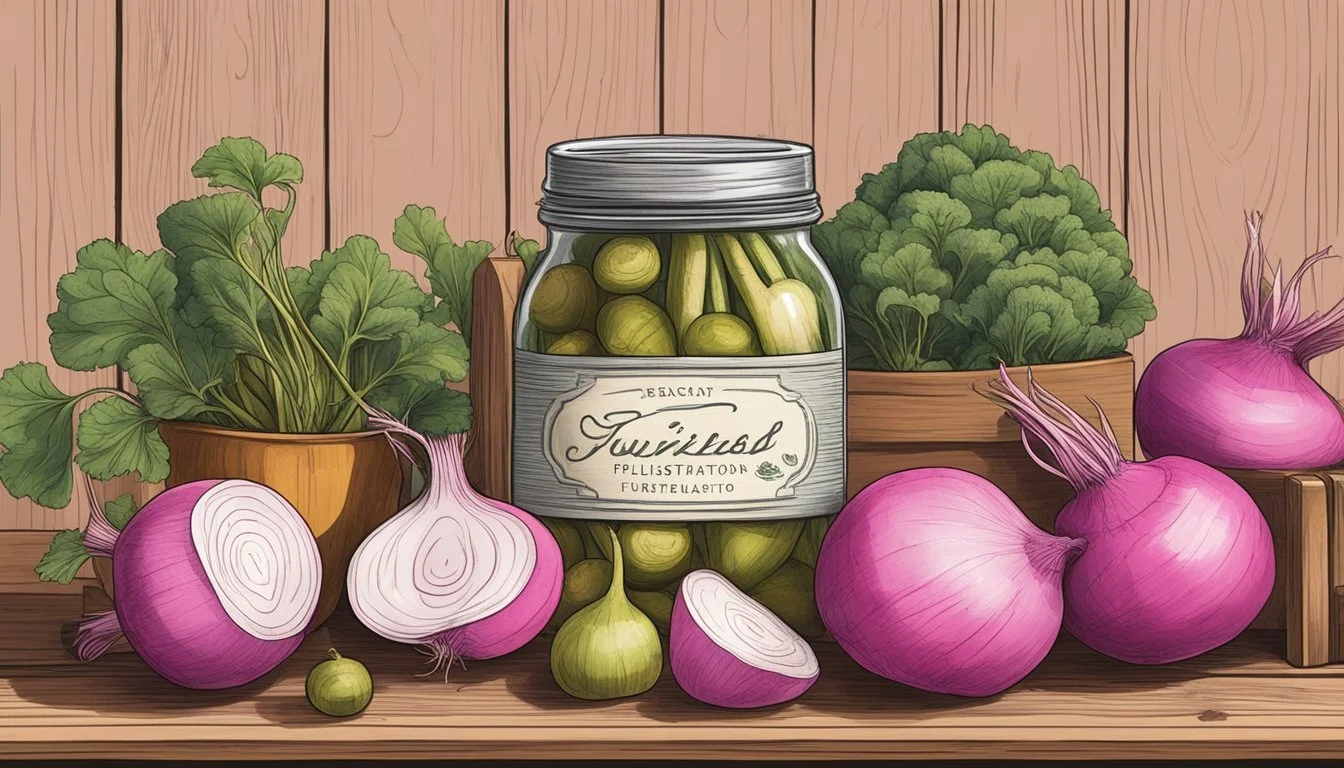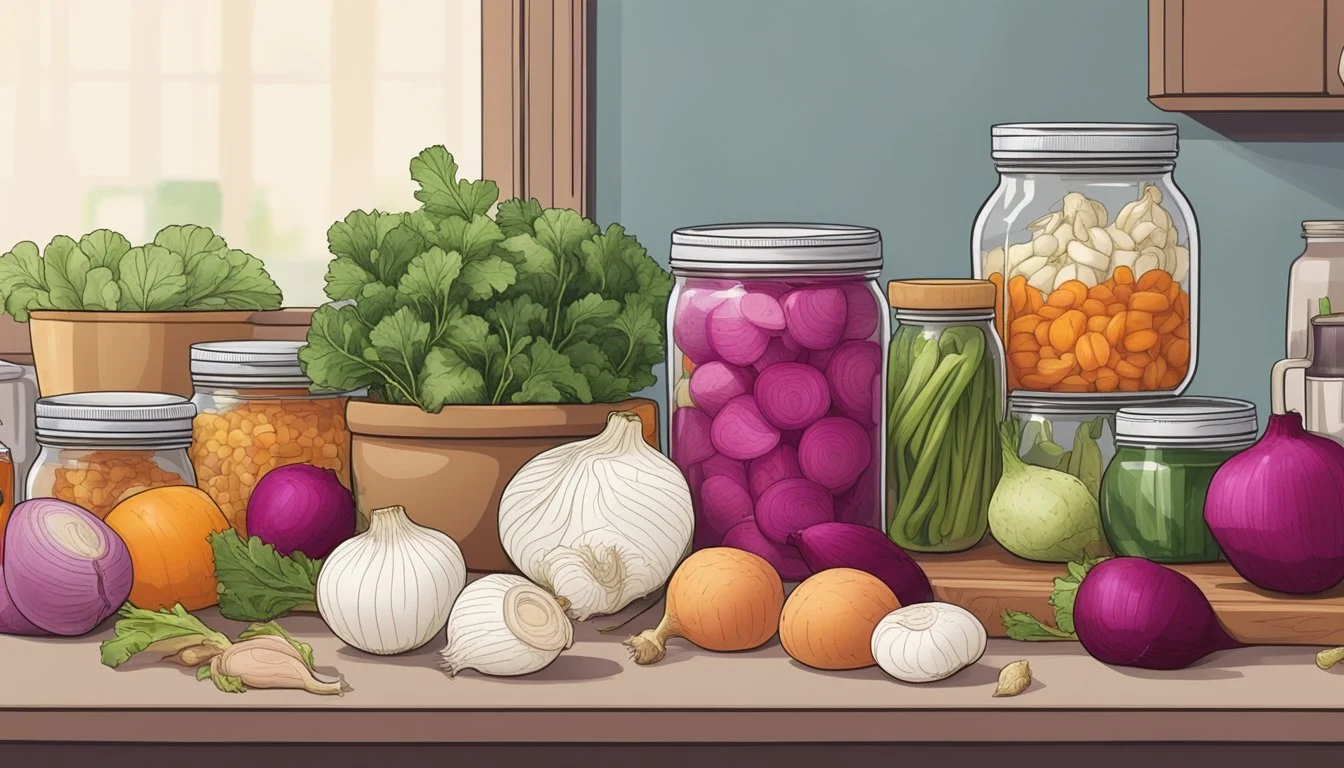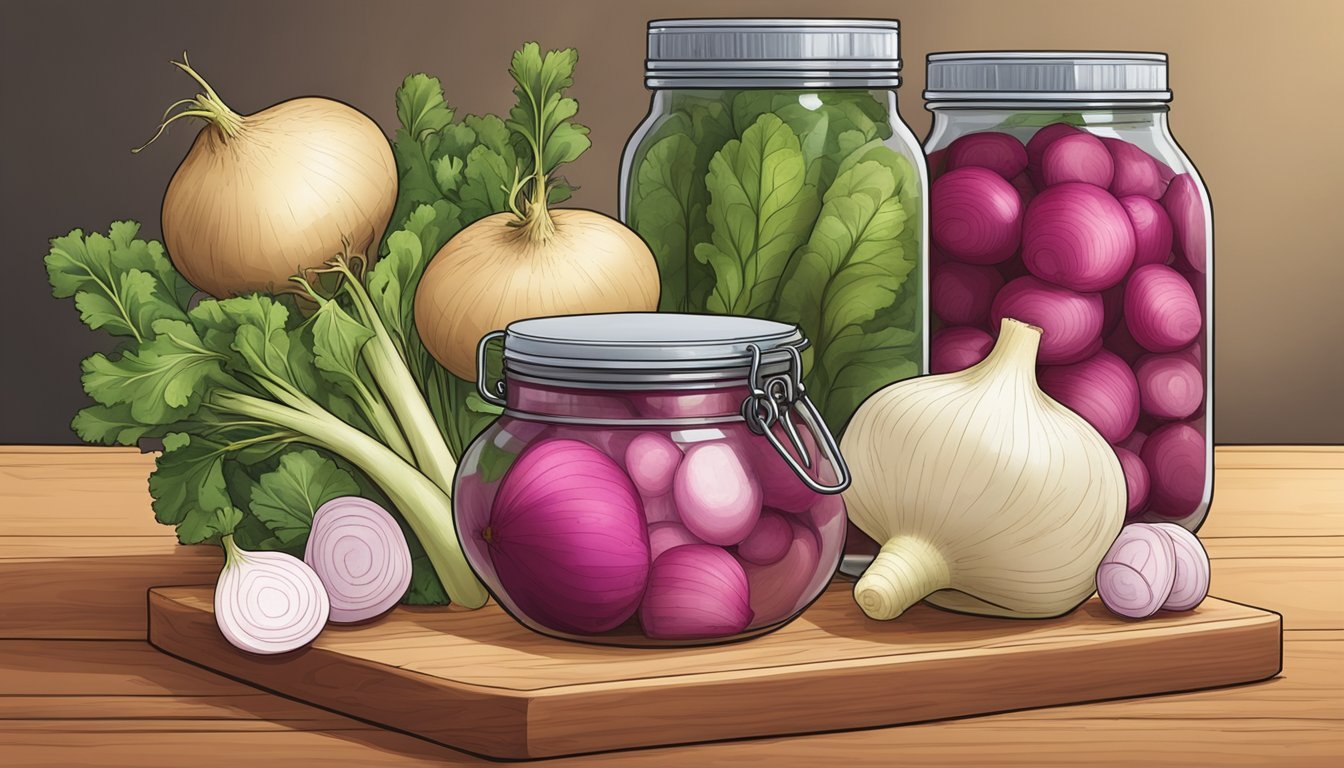Pickled Turnips Substitutes
Top Alternatives for Your Recipes
Pickled turnips add a distinctive tangy flavor to various dishes, making them a beloved ingredient in many cuisines. If you find yourself without turnips, there are several excellent substitutes that can achieve a similar taste and texture. These alternatives can rescue your recipe while maintaining that crisp, pickled goodness.
Common substitutes for pickled turnips include rutabagas, parsnips, radishes, and jicama. Each of these vegetables can stand in for turnips, offering unique textures and flavors that complement pickling spices. Rutabagas and parsnips, for instance, can emulate the mild bitterness of turnips, while radishes add a spicier kick. Jicama, with its juicy crunch, also makes an appealing alternative.
For cooks who value variety in their pantry, knowing these substitutes ensures flexibility and creativity in the kitchen. Incorporating these alternatives can keep your dishes vibrant and delicious, proving that even without pickled turnips, your culinary creations will not miss a beat.
Understanding Pickled Turnips
Pickled turnips are a popular staple in Middle Eastern cuisine, known for their tangy flavor and vibrant color. They offer numerous health benefits, including being low in calories and high in vitamins.
Origins and Culinary Uses
Pickled turnips have deep roots in Middle Eastern culinary traditions. They are often served in mezze platters alongside dishes such as hummus, falafel, and shawarma. Originally, they were a means of food preservation that evolved into a beloved side dish. The characteristic pink color often comes from adding a small piece of beet to the brine. This not only enhances the visual appeal but also imparts a slight sweetness to the pickles.
Nutritional Benefits
Pickled turnips are a low-calorie food, making them suitable for those who are calorie-conscious. They are a good source of fiber, which aids in digestion. Additionally, they contain vitamin C, which is essential for immune health. The pickling process also provides probiotics, which can contribute to gut health. The inclusion of beets not only adds color but also antioxidants, which help reduce oxidative stress in the body.
Preparation and Pickling Process
The process of preparing pickled turnips begins with selecting fresh turnips and peeling them. They are then cut into batons, usually about half an inch thick. For the brine, a mixture of water, kosher salt, and distilled white vinegar is prepared. The turnips are placed in jars with a small piece of beet for color. The brine is then poured over the vegetables, completely submerging them. Spices such as garlic, bay leaves, or peppercorns can be added for additional flavor.
Once prepared, the jars are sealed and left in the refrigerator for about a week to pickle. During this time, the vegetables absorb the flavors of the brine and spices, transforming into the tangy, crunchy pickles enjoyed in many Middle Eastern dishes. These pickles can last for several weeks when kept refrigerated, making them a convenient and delicious addition to various meals.
Culinary Substitutes for Pickled Turnips
Several vegetables can be used as substitutes for pickled turnips in different culinary contexts. These alternatives can bring similar textures and flavors to salads, sandwiches, cooked dishes, and as snacks or side dishes.
In Salads and Sandwiches
Daikon radish: Thinly sliced or julienned daikon radish is a crispy and mildly peppery substitute. It pairs well with greens, tomatoes, and meats like chicken shawarma.
Kohlrabi: A crunchy and slightly sweet option, kohlrabi can be sliced thin for sandwiches or cubed for salads. Its texture holds up well in mezze platters and adds a unique twist.
Salsify: Often described as oyster plant, salsify brings a delicate flavor to salads and sandwiches. It can be pickled similarly to turnips to retain a tangy taste.
For Cooking and Stews
Swede (rutabaga): When cooked, swede becomes tender with a mildly sweet flavor, making it an excellent turnip substitute in stews and soups. Use it in chunks alongside meats and other vegetables.
Celeriac (celery root): This root vegetable imparts a distinct celery flavor to soups and stews. It can be diced and simmered, adding both texture and a mild earthy taste.
Parsley root: With its aromatic properties, parsley root enhances the flavor of broths and stews. It blends well with other root vegetables and proteins, making it a versatile addition to any cooked dish.
As a Snack or Side Dish
Parsnips: Served roasted or steamed, parsnips offer a sweet and nutty flavor that is a pleasant alternative. They can be seasoned and eaten as a simple snack or served alongside a main course.
Pickled cucumbers: Commonly known as pickles, these can be a tangy, crunchy replacement. Perfect for snacking or adding to mezze platters with falafel and other small bites.
Carrots: When pickled, carrots deliver a crunchy and slightly sweet snack. Suitable for eating alone or as part of a side dish, they provide a bright color and appealing taste.
These substitutes offer a range of flavors and textures that can effectively replace pickled turnips in various recipes, adding diversity to your meals.
Top Turnip Substitute Options
When pickled turnips are not available, some excellent substitutes can provide similar flavors and textures. These substitutes can be grouped into root vegetables, cruciferous vegetables, and other tasty alternatives that can enhance your dishes.
Root Vegetables
Rutabagas are one of the closest substitutes, sharing a similar taste with a slightly sweeter and more complex flavor profile. They belong to the same plant family and offer a meaty, earthy texture.
Parsnips have a mildly sweet and nutty flavor with a starchy texture. While not a perfect match, they provide a good alternative with their distinctive taste and can work well in pickled preparations.
Celery Root (Celeriac) has a subtle celery-like flavor with a hint of sweetness. Its firm texture holds up well when pickled, making it a noteworthy substitute.
Carrots offer a sweeter flavor and crisp texture, making them a popular alternative. They bring a bright color to pickled dishes and pair well with various spices.
Beets not only provide an earthy flavor but also add a vibrant color to pickled recipes. They have a firmer texture that complements the crunchiness often desired in pickles.
Cruciferous Vegetables
Kohlrabi is a versatile member of the cabbage family with a slightly peppery and sweet flavor. It can be pickled to mimic the texture and taste of turnips, offering a unique twist on traditional recipes.
Radishes bring a sharp, peppery flavor that can act as a spicy and crunchy alternative. Their small size and varying colors can add visual interest to pickled assortments.
Swede (also known as Rutabaga) is another suitable cruciferous vegetable, similar to turnips in texture and taste. Its mildly sweet flavor makes it an excellent pickled substitute.
Other Tasty Alternatives
Jicama has a crisp texture and a subtle sweetness, providing a refreshing and crunchy alternative for pickling. Its juicy flesh makes it a unique substitute.
Sweet Potatoes bring a sweet and starchy texture that differs from turnips but can offer a delightful contrast in pickled recipes. Sliced thinly, they add a subtle sweetness and vibrant color.
These options provide a variety of flavors and textures that can replace pickled turnips in various culinary applications, offering versatility and creativity in your dishes.
Health Considerations When Choosing Substitutes
When choosing substitutes for pickled turnips, it's important to consider the nutritional content, including macronutrients, vitamins, antioxidants, and dietary fiber. Each substitute has unique health benefits and potential drawbacks.
Macronutrient Content
Different vegetables offer varying macronutrient profiles. For instance, potatoes are higher in calories and carbohydrates compared to turnips, which can impact overall calorie intake.
Turnips: Low in calories, moderate carbohydrates, minimal fat.
Potatoes: Higher calories and carbohydrates, low fat.
Kohlrabi: Similar calorie content, slightly higher carbohydrates.
Saturated fat is typically low in these substitutes, making them suitable for heart-healthy diets. Understanding these differences helps in making informed dietary choices.
Vitamins and Antioxidants
Vitamins and antioxidants are crucial for maintaining health. Substitutes like swede and parsnips provide many beneficial vitamins.
Turnips: Rich in Vitamin C, contributes to immune health.
Beetroot: High in Vitamin C and folate, offering significant antioxidant benefits.
Celeriac: Contains Vitamin K and Vitamin B6.
Kohlrabi: Packed with Vitamin C and potassium.
These vitamins aid in immune function, iron absorption, and reducing inflammation due to their antioxidant properties. Choosing substitutes with a high Vitamin C content can improve the nutritional quality of meals.
Dietary Fiber and Its Benefits
Fiber is essential for digestive health and can help manage weight by providing a feeling of fullness. Most turnip substitutes offer substantial fiber content.
Turnips: Good source of fiber, beneficial for digestion.
Parsnips: High in fiber, aids in maintaining a healthy gut.
Celeriac: Provides a crunchy texture and good fiber content.
Adequate fiber intake assists in lowering cholesterol levels and regulating blood sugar, which is beneficial for overall health. Incorporating fiber-rich substitutes can enhance the digestive benefits of meals.
Practical Tips for Substitution
When substituting pickled turnips, it's crucial to adjust flavors accurately, use appropriate measurements, and understand the best storage practices to maintain quality.
Adjusting Flavor Profiles
Pickled turnips have a distinctive taste that combines bitterness, sweetness, and savoriness. To replicate this, choose substitutes such as rutabaga, kohlrabi, or swede. Rutabagas lean on the sweeter side, offering a more nuanced flavor.
Add white vinegar or distilled white vinegar to recreate the tanginess. Enhance the savory notes by adding spices such as bay leaves, coriander seeds, or peppercorns in the pickling brine. For sweetness, a touch of honey balances the overall profile effectively.
A mix of table salt or kosher salt, fresh herbs, and olive oil can further refine the flavor to match that of pickled turnips. Experimenting with these ingredients can lead to a more delicious and balanced substitute.
Substitute Ratios and Measurements
Using the right ratios ensures the success of substituting turnips in pickling recipes. When replacing one cup of chopped turnips, use an equal amount of chopped rutabagas or kohlrabi.
If substituting with swede, maintain a 1:1 ratio. Consistency in measurements is key; using a measuring cup can help achieve accuracy.
For the pickling brine, maintain the proportions of vinegar, salt, and water similar to the original recipe. This consistent approach preserves the savory and tangy characteristics essential for pickled turnips.
Storage and Shelf Life
Proper storage of pickled turnip substitutes is critical to ensure freshness and longevity. Keep pickled vegetables in airtight jars stored in the refrigerator. Generally, pickled substitutes last for up to two months in the refrigerator.
For extended shelf life, use sterilized jars and ensure that the veggies are fully submerged in the brine. Adding a small amount of olive oil on top of the brine can help seal the flavor and prevent spoilage.
Label jars with dates to keep track of their refrigeration period and enjoy the pickled substitutes at their freshest.
Recipes Incorporating Turnip Substitutes
Turnip substitutes can seamlessly blend into various recipes, enhancing both flavor and nutrition. Here are some ways to incorporate turnip substitutes into salads and side dishes, main courses, and condiments and pickles.
Salads and Side Dishes
Substitutes like kohlrabi, jicama, and parsnips work well in salads and side dishes. For a refreshing twist, swap turnips with raw jicama in a crisp vegetable salad. Its crunchy texture pairs nicely with citrus juices and tahini sauce.
When roasted, parsnips serve as a comforting side dish. Coat them in olive oil, salt, and herbs before roasting for 30 minutes. They can also be diced and tossed in a mezze platter alongside hummus and other dips.
Kohlrabi slaw is another excellent choice. Shred kohlrabi and mix with carrots, red cabbage, and a tangy dressing. This slaw adds a delightful crunch to any meal.
Main Courses
In hearty main courses, substitutes like rutabagas, celeriac, and potatoes shine through. Rutabagas can be used in a beef casserole, contributing a subtly sweet flavor. Dice them alongside beef, carrots, and onions, then simmer them in a rich, white sauce for a comforting dish.
Celeriac adds depth to a vegetable soup. Combine it with leeks, carrots, and potatoes, then blend it for a creamy texture. This soup is both delicious and easy to make.
For a twist on traditional mashed potatoes, try using swedes (rutabagas). They provide a unique flavor and can be mashed with butter and cream to create a rich side for roasted meats.
Condiments and Pickles
Radishes, carrots, and celery root are great for making pickles and condiments. Pickled radishes are vibrant and tangy, perfect for adding to salads and sandwiches. Simply slice radishes thinly, then ferment in vinegar, water, salt, and sugar.
Carrot pickles are another versatile option. Shred them and pickle with spices like coriander and mustard seeds. These can be a zesty addition to mezze platters or served with tahini sauce.
For a unique twist, try pickled celeriac. Slice it thin and follow a similar pickling method. These pickles add a wonderful crunch to any dish and are particularly good in deep-fried snacks.
Each substitute brings its own unique flavor and texture, allowing for versatile and imaginative cooking.
Cultural Significance of Turnips and Their Pickles
Turnips have a rich history and diverse cultural significance. Originating in Europe and western Asia, they've been cultivated for over 3,000 years. They belong to the Brassicaceae family, which includes familiar vegetables like broccoli and cabbage.
In Middle Eastern cuisines, pickled turnips are a popular side dish. They're often served alongside meals to add a tangy crunch. This refrigerator pickle is easy to make and enhances the flavors of many dishes.
Pickled Turnips in Middle Eastern Culture:
Staple: Pickled turnips are a common sight on tables in countries like Lebanon and Syria.
Usage: They are frequently paired with falafel, shawarma, and kebabs.
Preparation: The turnips are sliced and soaked in a brine solution, often with beet juice to give them a distinctive pink hue.
Global Variations:
Japan: Senmaizuke, a type of pickled turnip, is a popular Japanese preparation that includes kombu and red chili.
Europe: Turnips have been a part of European cuisine for centuries, often featured in soups and as pickles.
The versatility and ease of making pickled turnips ensure their enduring place in various culinary traditions. They add not only flavor but also color and texture to meals. This widespread usage highlights their cultural significance across different regions.







